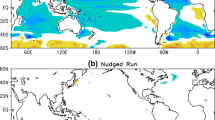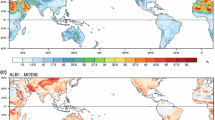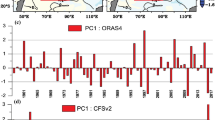Abstract
Sea surface temperature (SST) bias in the climate models has been a focus in the past, but subsurface temperature biases have not received much attention yet. In this study, subsurface temperature biases in the tropical North Pacific (TNP) are investigated by analyzing the CMIP6, CMIP5 and OMIP products, and by performing ocean model simulations. It is found that almost all the CMIP and OMIP simulations have a pronounced subsurface warm bias (SWB) in the northeastern tropical Pacific (NETP), and the model developments over the past decade do not indicate obvious improvements in bias pattern and magnitude from CMIP5 to the latest version CMIP6. This SWB is primarily caused by the model deficiencies in the simulated surface wind stress curl (WSC) in the NETP, which is too weak to produce a sufficient Ekman upwelling, a bias that also exists in OMIP simulations. The uncertainties in the parameterizations of the oceanic vertical mixing processes also make a great contribution, and it is demonstrated that the estimated oceanic vertical diffusivities are overestimated both in the upper boundary layer and the interior in the CMIP and OMIP simulations. The relationships between the SWB and the misrepresented oceanic vertical mixing processes are investigated by conducting several ocean-only experiments, in which the upper boundary layer mixing is modified by reducing the wind stirring effect in the Kraus-Turner type bulk mixed-layer scheme, and the interior mixing is constrained by using the Argo-derived diffusivity. By applying these modifications to oceanic vertical mixing schemes, the SWB is greatly reduced in the NETP. The consequences of this SWB are further analyzed. Because the thermal structure in the NETP can influence the simulations of oceanic circulations and equatorial upper-ocean thermal structure, the large SWB in the CMIP6 models tends to produce a weak equatorward water transport in the subsurface TNP, a weak equatorial upwelling and a warm equatorial upper ocean.


















Similar content being viewed by others
Availability of data and material
Not applicable.
Code availability
The data and computer codes used in the paper are available from the corresponding author (e-mail: rzhang@qdio.ac.cn).
References
Acreman DM, Jeffery CD (2007) The use of Argo for validation and tuning of mixed layer models. Ocean Model 19:53–69
Burls NJ, Muir L, Vincent EM, Fedorov A (2017) Extra-tropical origin of equatorial Pacific cold bias in climate models with links to cloud albedo. Clim Dyn 49:2093–2113
Capotondi A, Alexander MA, Deser C, McPhaden MJ (2005) Anatomy and Decadal Evolution Of The Pacific Subtropical-Tropical Cells (STCs)*. J Clim 18:3739–3758
Chen XY, Tung KK (2014) Varying planetary heat sink led to global-warming slowdown and acceleration. Science 345:897–903
Chen D, Rothstein LM, Busalacchi AJ (1994) A hybrid vertical mixing scheme and its application to tropical ocean models. J Phys Oceanogr 24:2156–2179
Cheng L, Kitade Y (2014) Quantitative evaluation of turbulent mixing in the Central Equatorial Pacific. J Oceanogr 70:63–79
Chowdary JS, Parekh A, Srinivas G, Gnanaseelan C, Fousiya TS, Khandekar R, Roxy MK (2016) Processes associated with the tropical Indian Ocean subsurface temperature bias in a coupled model. J Phys Oceanogr 46:2863–2875
Copernicus Climate Change Service (2017) ERA5: Fifth generation of ECMWF atmospheric reanalyses of the global climate. Copernicus Climate Change Service Climate Data Store (CDS). https://cds.climate.copernicus.eu/cdsapp#!/home
Draper DW, Long DG (2004) Evaluating the effect of rain on SeaWinds scatterometer measurements. J Geophys Res 109:C02005
Eyring V, Bony S, Meehl GA, Senior CA, Stevens B, Stouffer RJ, Taylor KE (2016) Overview of the Coupled Model Intercomparison Project Phase 6 (CMIP6) experimental design and organization. Geosci Model Dev 9:1937–1958
Fernández-Castro B et al (2014) Microstructure turbulence and diffusivity parameterization in the tropical and subtropical Atlantic, Pacific and Indian Oceans during the Malaspina 2010 expedition. Deep Sea Res Part I 94:15–30
Fox-Kemper B et al (2019) Challenges and prospects in ocean circulation models. Front Mar Sci. https://doi.org/10.3389/fmars.2019.00065
Furue R et al (2015) Impacts of regional mixing on the temperature structure of the equatorial Pacific Ocean. Part 1: vertically uniform vertical diffusion. Ocean Model 91:91–111
Gao C, Zhang R-H (2017) The roles of atmospheric wind and entrained water temperature (Te) in the second-year cooling of the 2010–12 La Niña event. Clim Dyn 48:597–617
Good SA, Martin MJ, Rayner NA (2013) EN4: quality controlled ocean temperature and salinity profiles and monthly objective analyses with uncertainty estimates. J Geophys Res 118:6704–6716
Gordon CT, Rosati A, Gudgel R (2000) Tropical sensitivity of a coupled model to specified ISCCP low clouds. J Clim 13:2239–2260
Griffies SM et al (2009) Coordinated ocean-ice reference experiments (COREs). Ocean Model 26:1–46
Griffies SM et al (2015) Impacts on ocean heat from transient mesoscale eddies in a hierarchy of climate models. J Clim 28:952–977
Griffies SM et al (2016) OMIP contribution to CMIP6: experimental and diagnostic protocol for the physical component of the Ocean Model Intercomparison Project. Geosci Model Dev 9:3231–3296
Guilyardi E et al (2009) Understanding El Niño in ocean-atmosphere general circulation models: progress and challenges. Bull Am Meteorol Soc 90:325–340
Jia YL, Furue R, McCreary JP (2015) Impacts of regional mixing on the temperature structure of the equatorial Pacific Ocean. Part 2: Depth-dependent vertical diffusion. Ocean Model 91:112–127
Jia Y, Richards KJ, Annamalai H (2021) The impact of vertical resolution in reducing biases in sea surface temperature in a tropical Pacific Ocean model. Ocean Model 157:101722
Jochum M (2009) Impact of latitudinal variations in vertical diffusivity on climate simulations. J Geophys Res 114:C01010
Johnson GC, McPhaden MJ (1999) Interior pycnocline flow from the subtropical to the equatorial Pacific Ocean. J Phys Oceanogr 29:3073–3089
Kim ST, Cai W, Jin F-F, Yu J-Y (2014) ENSO stability in coupled climate models and its association with mean state. Clim Dyn 42:3313–3321
Kim ST, Jeong H-I, Jin F-F (2017) Mean bias in seasonal forecast model and ENSO prediction error. Sci Rep 7:6029
Kunze E, Firing E, Hummon JM, Chereskin TK, Thurnherr AM (2006) Global abyssal mixing inferred from lowered ADCP shear and CTD strain profiles. J Phys Oceanogr 36:1553–1576
Large WG, Yeager SG (2009) The global climatology of an interannually varying air-sea flux data set. Clim Dyn 33:341–364
Li G, Xie S-P (2014) Tropical biases in CMIP5 multimodel ensemble: the excessive equatorial pacific cold tongue and double ITCZ problems. J Clim 27:1765–1780
Li G, Xie S-P, Du Y, Luo Y (2016) Effects of excessive equatorial cold tongue bias on the projections of tropical Pacific climate change. Part I: the warming pattern in CMIP5 multi-model ensemble. Clim Dyn 47:3817–3831
Lilly JM, Rhines PB, Visbeck M, Davis R, Lazier JRN, Schott F, Farmer D (1999) Observing deep convection in the Labrador sea during winter 1994/95. J Phys Oceanogr 29:2065–2098
Lu P, McCreary JP (1995) Influence of the ITCZ on the flow of thermocline water from the subtropical to the equatorial Pacific Ocean. J Phys Oceanogr 25:3076–3088
Ma C-C, Mechoso CR, Robertson AW, Arakawa A (1996) Peruvian stratus clouds and the tropical Pacific Circulation: a coupled ocean-atmosphere GCM study. J Climate 9:1635–1645
MacKinnon JA et al (2017) Climate process team on internal wave-driven ocean mixing. Bull Am Meteorol Soc 98:2429–2454
McPhaden MJ, Zhang D (2002) Slowdown of the meridional overturning circulation in the upper Pacific Ocean. Nature 415:603–608
Niiler P (1977) One-dimensional models of the upper ocean, Modelling and Prediction of the Upper Layers of the Ocean EB Kraus, 143–172. Pergamon, New York
Peters H, Gregg MC, Toole JM (1988) On the parameterization of equatorial turbulence. J Geophys Res 93:1199–1218
Rackow T et al (2019) Sensitivity of deep ocean biases to horizontal resolution in prototype CMIP6 simulations with AWI-CM1.0. Geosci Model Dev 12:2635–2656
Risien CM, Chelton DB (2008) A global climatology of surface wind and wind stress fields from eight years of QuikSCAT scatterometer data. J Phys Oceanogr 38:2379–2413
Rothstein LM, Zhang R-H, Busalacchi AJ, Chen D (1998) A numerical simulation of the mean water pathways in the subtropical and tropical Pacific Ocean. J Phys Oceanogr 28:322–343
Rudnick DL, Ferrari R (1999) Compensation of horizontal temperature and salinity gradients in the ocean mixed layer. Science 283:526–529
Sasaki W, Richards KJ, Luo JJ (2013) Impact of vertical mixing induced by small vertical scale structures above and within the equatorial thermocline on the tropical Pacific in a CGCM. Clim Dyn 41:443–453
Seo H, Jochum M, Murtugudde R, Miller AJ (2006) Effect of ocean mesoscale variability on the mean state of tropical Atlantic climate. Geophys Res Lett 33:L09606
Small RJ et al (2014) A new synoptic scale resolving global climate simulation using the Community Earth System Model. J Adv Model Earth Syst 6:1065–1094
Song F, Zhang GJ (2020) The impacts of horizontal resolution on the seasonally dependent biases of the northeastern pacific ITCZ in coupled climate models. J Clim 33:941–957
Sun Z, Liu H, Lin P, Tseng Y-H, Small J, Bryan F (2019) The modeling of the north equatorial countercurrent in the community earth system model and its oceanic component. J Adv Model Earth Syst 11:531–544
Thomas MD, Fedorov AV (2017) The eastern subtropical pacific origin of the equatorial cold bias in climate models: a lagrangian perspective. J Clim 30:5885–5900
Thurnherr AM, Laurent LCS (2011) Turbulence and diapycnal mixing ove the East Pacific Rise crest near 10°N. Geophys. Res Lett 38:L15613
Tsujino H et al (2018) JRA-55 based surface dataset for driving ocean–sea-ice models (JRA55-do). Ocean Modell 130:79–139
Tsujino H et al (2020) Evaluation of global ocean–sea-ice model simulations based on the experimental protocols of the Ocean Model Intercomparison Project phase 2 (OMIP-2). Geosci Model Dev 13:3643–3708
Vannière B, Guilyardi E, Madec G, Doblas-Reyes FJ, Woolnough S (2013) Using seasonal hindcasts to understand the origin of the equatorial cold tongue bias in CGCMs and its impact on ENSO. Clim Dyn 40:963–981
Wang G, Cheng L, Abraham J, Li C (2018) Consensuses and discrepancies of basin-scale ocean heat content changes in different ocean analyses. Clim Dyn 50:2471–2487
Weissman DE, Bourassa MA, Tongue J (2002) Effects of rain rate and wind magnitude on seawinds scatterometer wind speed errors. J Atmos Oceanic Technol 19:738–746
Wittenberg AT, Rosati A, Lau N-C, Ploshay JJ (2006) GFDL’s CM2 global coupled climate models. Part III: tropical pacific climate and ENSO. J Climate 19:698–722
Woelfle MD, Yu S, Bretherton CS, Pritchard MS (2018) Sensitivity of coupled tropical Pacific model biases to convective parameterization in CESM1. J Adv Model Earth Syst 10:126–144
Xu Z, Li M, Patricola CM, Chang P (2014) Oceanic origin of southeast tropical Atlantic biases. Clim Dyn 43:2915–2930
Ying J, Huang P, Lian T, Tan H (2019) Understanding the effect of an excessive cold tongue bias on projecting the tropical Pacific SST warming pattern in CMIP5 models. Clim Dyn 52:1805–1818
Zhang R-H et al (2020) A review of progress in coupled ocean-atmosphere model developments for ENSO studies in China. Journal of Oceanology and Limnology 38:930–961
Zhu Y, Zhang R-H (2018a) Scaling wind stirring effects in an oceanic bulk mixed layer model with application to an OGCM of the tropical Pacific. Clim Dyn 51:1927–1946
Zhu Y, Zhang R-H (2018b) An argo-derived background diffusivity parameterization for improved ocean simulations in the tropical Pacific. Geophys Res Lett 45:1509–1517
Zhu Y, Zhang R-H (2019) A modified vertical mixing parameterization for its improved ocean and coupled simulations in the tropical Pacific. J Phys Oceanogr 49:21–37
Zhu C, Liu Z, Gu S (2018) Model bias for South Atlantic Antarctic intermediate water in CMIP5. Clim Dyn 50:3613–3624
Zhu Y, Zhang R-H, Sun J (2020) North Pacific upper-ocean cold temperature biases in CMIP6 simulations and the role of regional vertical mixing. J Clim 33:7523–7538
Zhu Y, Zhang R-H, Li D, Chen D (2021) The thermocline biases in the tropical North Pacific and their attributions. J Clim 34:1635–1648
Acknowledgements
The authors wish to thank the anonymous reviewers for their numerous comments that helped to improve the original manuscript. We thank Andreas M. Thurnherr at Lamont-Doherty Earth Observatory for providing the LADDER data. We acknowledge the World Climate Research Programme, which, through its Working Group on Coupled Modelling, coordinated and promoted CMIP6. We thank the climate modeling groups for producing and making available their model output, the Earth System Grid Federation (ESGF) for archiving the data and providing access, and the multiple funding agencies who support CMIP6 and ESGF. This research is supported by the National Natural Science Foundation of China (Grant Nos. 41906007, 41690122(41690120), 42030410, 41705082, 41421005), the National Key Research and Development Program of China (No. 2017YFC1404102(2017YFC1404100)), the Strategic Priority Research Program of Chinese Academy of Sciences (Grant Nos. XDB 40000000 and XDB 42000000), and the Shandong Taishan Scholarship.
Funding
This research is supported by the National Natural Science Foundation of China (Grant Nos. 41906007, 41690122(41690120), 42030410, 41705082, 41421005), the National Key Research and Development Program of China (No. 2017YFC1404102(2017YFC1404100)), the Strategic Priority Research Program of Chinese Academy of Sciences (Grant Nos. XDB 40000000 and XDB 42000000), and the Shandong Taishan Scholarship.
Author information
Authors and Affiliations
Corresponding author
Ethics declarations
Conflict of interest
The authors declare no competing interests.
Additional information
Publisher's Note
Springer Nature remains neutral with regard to jurisdictional claims in published maps and institutional affiliations.
Rights and permissions
About this article
Cite this article
Zhu, Y., Zhang, RH. & Li, D. An ocean modeling study to quantify wind forcing and oceanic mixing effects on the tropical North Pacific subsurface warm bias in CMIP and OMIP simulations. Clim Dyn 58, 999–1014 (2022). https://doi.org/10.1007/s00382-021-05946-y
Received:
Accepted:
Published:
Issue Date:
DOI: https://doi.org/10.1007/s00382-021-05946-y




